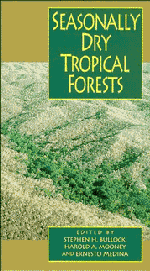Book contents
- Frontmatter
- Contents
- List of contributors
- Acknowledgements
- 1 Introduction
- 2 Dry forests of Central America and the Caribbean
- 3 Overview of the Brazilian caatinga
- 4 Savannas, woodlands and dry forests in Africa
- 5 Dry forest ecosystems of Thailand
- 6 The Cenozoic record of tropical dry forest in northern Latin America and the southern United States
- 7 Diversity and floristic composition of neotropical dry forests
- 8 Vertebrate diversity, ecology and conservation in neotropical dry forests
- 9 Diversity of life forms of higher plants in neotropical dry forests
- 10 Drought responses of neotropical dry forest trees
- 11 Plant reproduction in neotropical dry forests
- 12 Plant–herbivore interactions in Mesoamerican tropical dry forests
- 13 Biomass distribution and primary productivity of tropical dry forests
- 14 Nutrient cycling in tropical deciduous forests
- 15 Biology of the belowground system of tropical dry forests
- 16 Nitrogen trace gas emissions in a tropical dry forest ecosystem
- 17 Conversion of tropical dry forest to pasture and agriculture
- 18 Ethnobotany of the Mexican tropical dry forests
- Index
12 - Plant–herbivore interactions in Mesoamerican tropical dry forests
Published online by Cambridge University Press: 07 September 2010
- Frontmatter
- Contents
- List of contributors
- Acknowledgements
- 1 Introduction
- 2 Dry forests of Central America and the Caribbean
- 3 Overview of the Brazilian caatinga
- 4 Savannas, woodlands and dry forests in Africa
- 5 Dry forest ecosystems of Thailand
- 6 The Cenozoic record of tropical dry forest in northern Latin America and the southern United States
- 7 Diversity and floristic composition of neotropical dry forests
- 8 Vertebrate diversity, ecology and conservation in neotropical dry forests
- 9 Diversity of life forms of higher plants in neotropical dry forests
- 10 Drought responses of neotropical dry forest trees
- 11 Plant reproduction in neotropical dry forests
- 12 Plant–herbivore interactions in Mesoamerican tropical dry forests
- 13 Biomass distribution and primary productivity of tropical dry forests
- 14 Nutrient cycling in tropical deciduous forests
- 15 Biology of the belowground system of tropical dry forests
- 16 Nitrogen trace gas emissions in a tropical dry forest ecosystem
- 17 Conversion of tropical dry forest to pasture and agriculture
- 18 Ethnobotany of the Mexican tropical dry forests
- Index
Summary
Introduction
The tropical dry forests of Mesoamerica constitute an ecological theater where a plethora of herbivory plays occur with a great variety of forms, intensity and spatio-temporal variation. In contrast to other types of tropical forests, the herbivory events in dry forests are frequently quite apparent or visible to the eyes of the professional or even the casual observer. In these forests, for example, complete: defoliation events are not so uncommon, particularly on some deciduous (as opposed to evergreen) species of trees and shrubs, and these occurrences suggest that massive defoliations and insect ‘outbreaks’ are not exclusively extra-tropical phenomena. Likewise, levels of seed predation for some individuals in some species can sometimes be in the order of 100% (e.g. Acacia cornigera: R. Dirzo, personal observation).
From the point of view of the consumers, the protagonists of these ecological plays comprise two major groups.
1 The array of vertebrates spans four orders of magnitude in body weight. In Santa Rosa National Park (‘SRNP’, Guanacaste Province, Costa Rica), these include forest understory mammals ranging from tapirs (Tapirus bairdii) (200,000 g) and white-tailed deer (Odocoileus virginianus), which actively consume seeds and foliage, to 30 g seed-eating mice such as Liomys pictus or Oryzomys palustris, and forest canopy mammals ranging from leaf- and flower-eating howler monkeys (Alouatta palliata) (8000 g) to small (40 g) leaf- and seed-eating rats such as Nyctomys sumichrastii.
2 The array of invertebrate herbivores is extremely diverse. In SRNP these include not less than 110 species of seed-eating beetles (Janzen, 1980), and 3140 species of folivorous caterpillars (Janzen, 1988).
Likewise, from the point of view of the resource base, the plants also comprise a genetically diverse array.
- Type
- Chapter
- Information
- Seasonally Dry Tropical Forests , pp. 304 - 325Publisher: Cambridge University PressPrint publication year: 1995
- 63
- Cited by



